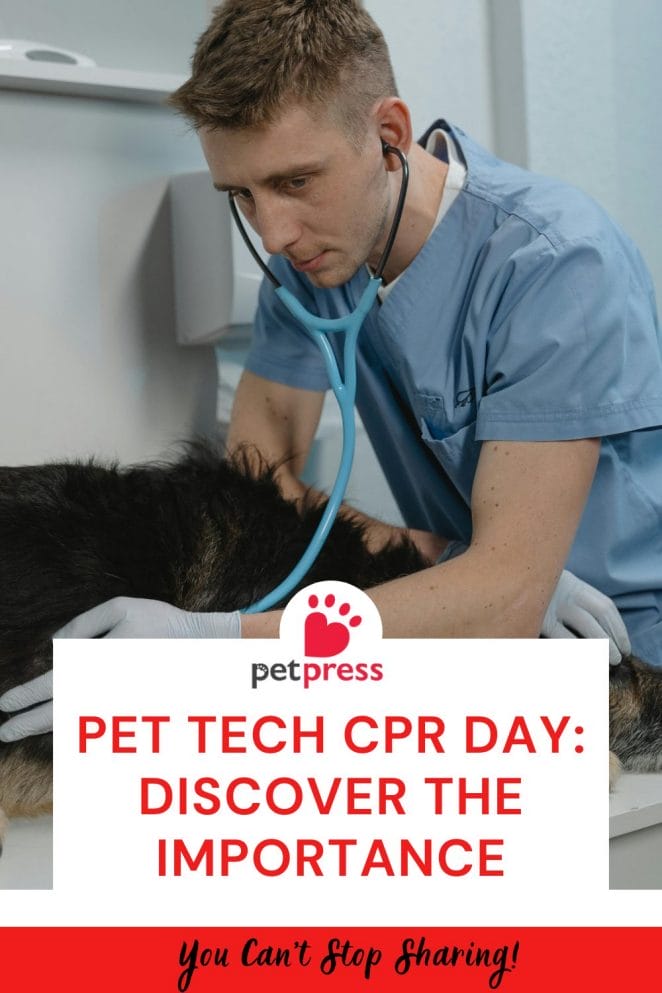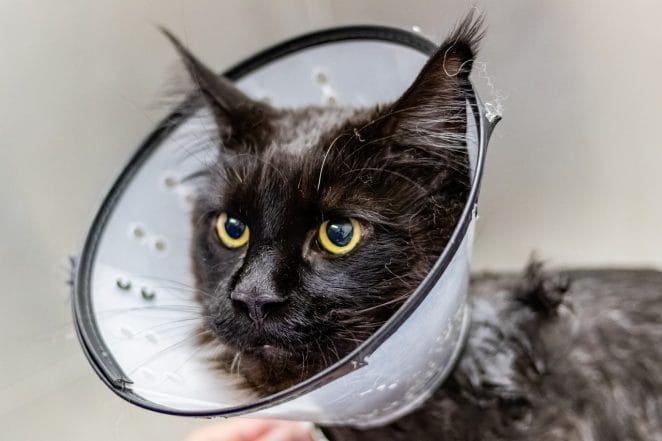
Don’t forget to circle April 23 on your calendar for Pet Tech CPR Day.
This special day, established by PetTech in 2018, is dedicated to teaching life-saving skills to our furry friends.
As technology becomes more integrated into our lives, it’s important to stay informed about how it can help us care for our pets.
Join us in raising awareness about pet first aid and CPR, and let’s ensure our beloved companions stay safe and healthy. Together, we can give them the best care they deserve!
Basic Principles of Pet Tech CPR Day
Pet CPR (Cardiopulmonary Resuscitation) is a crucial skill for pet owners and caregivers to know in case of emergencies. Here are the basic principles:
Assess the Situation
Ensure that the scene is safe for both you and the pet. Check for any potential dangers or hazards before approaching the animal.
Check for Responsiveness
Gently tap the pet and call its name to see if it responds. Check for breathing by observing the rise and fall of the chest or feeling for breath on your hand placed near the nose.
Establish an Airway
If the pet is unconscious and not breathing, gently extend its head and neck to create a straight line.
Clear any obstructions from the mouth and throat, being careful not to get bitten.
Check for Pulse
After establishing an airway, check for a pulse by feeling for the femoral artery (located inside the hind leg where it meets the body). If you cannot feel a pulse, it’s time to begin CPR.
Perform Chest Compressions
Lay the pet on its side on a flat surface. For dogs, place one hand over the widest part of the chest, just behind the front legs.
For cats and small animals, compressions may be performed with the thumb and fingers around the chest.
Administer chest compressions at a rate of 100-120 compressions per minute. Compress the chest approximately 1/3 to 1/2 its width.
Administer Rescue Breaths
After 30 chest compressions, give two rescue breaths. Close the pet’s mouth and breathe directly into its nose, making sure to create a seal. Watch for chest rise as you deliver each breath.
Continue Cycles
Continue cycles of 30 compressions followed by 2 rescue breaths until the pet resumes breathing on its own, emergency help arrives, or you are physically unable to continue.
Monitor Vital Signs
Keep monitoring the pet’s breathing and pulse while administering CPR. Be prepared to adjust your technique based on any changes in the pet’s condition.
Seek Veterinary Care
Even if the pet responds to CPR and starts breathing again, it’s essential to seek immediate veterinary attention.
CPR is a temporary measure and does not address underlying medical issues that may have caused the emergency.
Demonstrations For Pet Tech CPR Day

Demonstrations and hands-on practice are essential components of learning pet CPR effectively. Here’s how you can incorporate them:
Certified Courses
Enroll in certified pet CPR and first aid courses offered by reputable organizations or veterinary clinics.
These courses typically include both theoretical instruction and practical demonstrations followed by hands-on practice sessions.
Online Resources
Many organizations offer online resources, including videos and tutorials, demonstrating pet CPR techniques.
While these resources can provide valuable insights, they should be supplemented with practical, hands-on training whenever possible.
Local Workshops
Look for local workshops or training sessions conducted by animal shelters, veterinary clinics, or pet care organizations.
These workshops often provide opportunities for participants to practice CPR techniques under the guidance of experienced instructors.
Role-playing Scenarios
Create role-playing scenarios where participants can practice responding to simulated pet emergencies.
Assign roles such as pet owner, bystander, and rescuer, and simulate various emergencies to enhance preparedness and confidence.
Manikin Practice
Use pet CPR manikins or stuffed animals to simulate real-life scenarios during training sessions.
Manikins are designed to mimic the size, weight, and anatomy of pets, allowing participants to practice chest compressions, airway management, and rescue breathing techniques.
Feedback and Guidance
Provide constructive feedback and guidance to participants during hands-on practice sessions.
Encourage them to focus on proper hand placement, compression depth, and breathing techniques to optimize effectiveness.
Repetition and Reinforcement
Encourage participants to repeat CPR techniques multiple times to reinforce muscle memory and confidence.
Repetition is key to mastering pet CPR and ensuring readiness to respond effectively during emergencies.
Scenario-Based Training
Incorporate scenario-based training exercises that simulate common pet emergencies, such as choking, drowning, or trauma.
Encourage participants to apply their knowledge of CPR techniques in realistic scenarios to enhance problem-solving skills and decision-making under pressure.
Pet Tech CPR Day Common Mistakes

Avoiding common mistakes in pet CPR is crucial for maximizing the chances of success in an emergency. Here are some common errors to avoid:
Delaying Action
Waiting too long to start CPR can significantly reduce the chances of successful resuscitation. Act promptly if the pet is unresponsive and not breathing.
Incorrect Hand Placement
Placing your hands incorrectly during chest compressions can be ineffective or even harmful.
Ensure that your hands are positioned over the widest part of the chest, just behind the front legs, to compress the heart effectively.
Inadequate Compression Depth
Failing to compress the chest deeply enough can compromise the effectiveness of CPR.
Aim for compressions that depress the chest approximately 1/3 to 1/2 its width to adequately circulate blood.
Compression Rate Too Slow or Fast
Compressions should be delivered at a rate of 100-120 compressions per minute. Striking a balance between speed and depth is essential for optimal circulation.
Not Checking for a Pulse
Neglecting to check for a pulse before initiating CPR can lead to unnecessary chest compressions. Confirm the absence of a pulse before starting compressions.
Resources for Further Learning of Pet Tech CPR Day
Certified Pet CPR and First Aid Courses
Enroll in courses offered by reputable organizations or veterinary clinics to learn essential life-saving techniques and emergency preparedness strategies specific to pets.
Online Resources
Explore websites, videos, and tutorials provided by trusted sources such as veterinary associations, animal welfare organizations, and government agencies.
These resources often cover a wide range of topics, including pet first aid, disaster preparedness, and evacuation planning.
Local Workshops and Training Sessions
Look for workshops, seminars, or training sessions conducted by animal shelters, pet care professionals, or emergency management agencies in your area.
These events may offer hands-on practice and guidance from experienced instructors.
Books and Publications
Seek out books, guides, and publications written by veterinary professionals or experienced pet owners that focus on emergency preparedness, first aid, and pet care during disasters.
Conclusion
In conclusion, Pet Tech CPR Day is essential for pet owners to safeguard their pets’ well-being and safety during crises.
By being proactive, staying informed, and acquiring the necessary skills and resources, pet owners can effectively respond to emergencies and provide the best possible care for their beloved companions.
Frequently Asked Questions
Pet CPR Day is an annual event dedicated to raising awareness about the importance of pet first aid and CPR. It provides pet owners with essential life-saving skills to respond effectively in emergencies, potentially saving their pet’s life.
Pet CPR Day is celebrated on April 23rd each year. Mark your calendars and join in the effort to learn how to protect your furry friends in times of need.
Pet CPR Day events are often organized by pet care organizations, veterinary clinics, animal shelters, and community groups passionate about promoting pet safety and well-being. These events may include workshops, demonstrations, and training sessions.
At a Pet CPR Day event, you can expect to learn essential pet first aid and CPR techniques through demonstrations, hands-on practice sessions, and educational resources. Experienced instructors may guide participants through proper procedures and offer tips for emergency preparedness.
While Pet CPR Day primarily targets pet owners, it is open to anyone interested in learning life-saving skills for animals. Whether you’re a pet owner, animal lover, or professional in the pet care industry, Pet CPR Day offers valuable knowledge and resources to help you protect and care for pets in emergencies.
—————————————–


GIPHY App Key not set. Please check settings